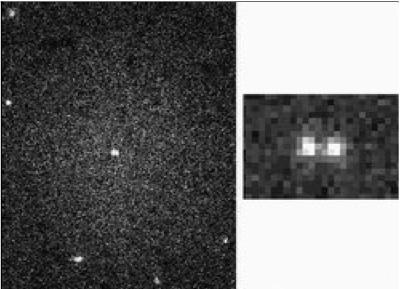Little Galaxies Have Black Holes Too

From the American Astronomical Society Meeting in Seattle: A team represented by Victor Debattista from University of Washington has found a supermassive Black Hole at the centre of a dwarf galaxy. The galaxy VCC128 is 54 million light-years away in our Virgo Cluster, and has only 1% of our galaxy's mass. The team found the Black Hole by sifting through archival Hubble Space Telescope data. Their poster was presented Sunday, for these days even big discoveries are presented as posters.
The news in year 007 gets better and better. We saw just last week that, as predicted, globulars contain Black Holes. Dwarf galaxies are thought to develop from globular clusters. This supermassive Black Hole has a mass between 1 million and 50 million solar masses. In the right photo it is orbited by a ring of stars. "It had been speculated that dwarf galaxies like this could not make black holes," Debattista said. Perhaps the Black Hole was there before the galaxy.


3 Comments:
Hi Babe, one silly question, driven by the fact that we do see gravitationally-built objects which might NOT contain black holes after all.
What would happen if a black hole inside a big galaxy disappeared abruptly, taking with itself all its mass to another dimension ?
What would be the morphological effect to the galaxy by the discontinuity in the gravitational field ?
A fun question to ask...
Cheers,
T.
HI T: The supermassive Black Holes within galaxies are in no danger of evaporating. If a tiny Black Hole inside, say Mars, evaporated its mass would by then be too tiny to make much difference. Only mass near its event horizon would be in danger of disappearing. There would be a release of Hawking radiation which would make the neighbourhood hot for a while.
Yes, but my idea was really much more crackpot-like, not just an evaporation but a total, instantaneous disappearance. I was having fun thinking at the negative gravitational wave resulting from the sudden disappearance of mass.
Cheers,
T.
Post a Comment
<< Home